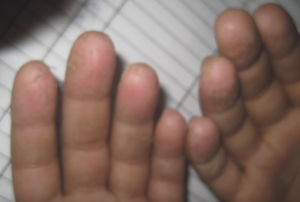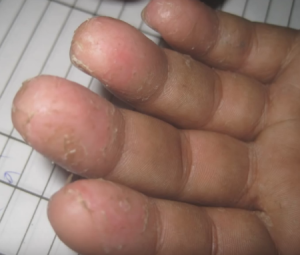A person suffering from exfoliative keratolysis could experience sores and peeling skin; skin peeling occurs gradually over time resulting in formation of very dry and itchy skin. At times it may affect the tips of the fingers; cracks formed due to the skin condition could go deeper into the skin. This further hardens and numbs the skin. Extreme cases could result in secondary level of viral skin infections.
Exfoliative keratolysis is more common and widespread in the summer season and generally children and young adults are the victims. People whose hands are clammy and sticky are more susceptible to suffer from skin peeling of the hands. The cause for the skin disorder is not known, but it could be due to excess use of detergent and soap for a long time.
At times, the condition may be confused with psoriasis. This is because the symptoms are similar i.e. peeling of skin. Still, exfoliative keratolysis differs from psoriasis as the former skin disorder affects mainly the palm and sole skin. Also, in psoriasis itchiness is severe in comparison to exfoliative keratolysis.
The condition does not need any kind specific treatment. It is not harmful, doesn’t cause pain and heals on its own. However, medical expert advice is needed if the skin bleeds and cracks.
Symptoms of Exfoliative keratolysis
A few common symptoms are as follows:
- Blisters: Tiny air-fluid filled blisters may appear on the palm skin and give it an ugly appearance. Later, these blisters could start peeling off or develop cracks or splits to form into skin tags. Formation of such numerous skin tags makes the palm look flaky and the layer of the skin fully peels off. Then, the new skin that gets exposed usually takes time to become normal and solid.
- The finger tips, palms, soles are the main areas where patients may develop such blisters.
- Continuous peeling of the skin from the fingers and finger tips may pose a lot of problems skin re-growth. The new skin layer could take a long time to be normal and instead become a hard layer of skin.
- In case the lower area of the finger suffers from blister, then deep cracks may develop, resulting in numb sensations and hardened skin. This may occur along with continuous and prolonged skin peeling, problems in getting cured, and a very long healing and recovery process.
- Itchy feeling usually doesn’t occur in and around the cracked sores.
- Exfoliative keratolysis may persist after some weeks even if the skin disorder is healed and becomes normal.
- Exfoliative keratolysis is neither painful nor harmful; still the unsightly appearance could cause low self-esteem, distress, and at times depression.
- If the skin peels off severely, then the open area is prone to dangerous ultra-violet rays and infections. This in turn will affect the general health of the affected person.
Causes of Exfoliative keratolysis
Medical expert have not yet been able to find out the exact cause of exfoliative keratolysis. It is known that the topmost layer of the skin epidermis is affected by the condition. Also, the epidermis consist of numerous keratin layers and that it is keratin that helps to maintain the skin’s strength and suppleness.Breakdown of layers of keratin lessens the strength and flexibility of the skin. It also reduces the capacity to be a barrier to water. All of this leads to exfoliative keratolysis and subsequent peeling of the skin.
Some risk factors that could increase the vulnerability to developing exfoliative keratolysis are as follows:
- Soap, detergent, and such other solvent may result in peeling of the skin.
- Continuous perspiration degrades the layer of skin and causes peeling of the skin
- Allergies are also one of the causes for exfoliation of skin
- Exfoliative keratolysis could be triggered by genetic disposition to skin infections; this may happen after skin is being exposed to some outside factors.
- Tension, stress might also cause the skin problems or aggravate any underlying instances of skin infections.
Treatment of Exfoliative keratolysis
It is not a severe skin disorder. It gets cured on its own and doesn’t require medical expert treatment; also it doesn’t cause any lasting skin injuries.
- When the skin peels off new skin layer replaces the open area, thereby no treatment is required. Topical steroid are not helpful in treating exfoliative keratolysis.
- To reduce dryness of the skin, silicone, urea, etc., containing emollients can be used. It also helps in preventing secondary level of infection.
- In serious cases, photochemotherapy may be required.
The best way of treating exfoliative keratolysis is prevention by following the below listed guidelines:
- Keep hands and feet clean at all times
- Vulnerable people, such as those with weak immune systems and those with a genetic predisposition, have to be cautious. They have to keep away from excessive sweating, especially during summer months.
- Avoid the constant use of soap, detergent, or contact with other chemicals and allergens.
Exfoliative Keratolysis – Pictures



